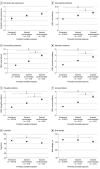Associations Between Prenatal Cannabis Exposure and Childhood Outcomes: Results From the ABCD Study
- PMID: 32965490
- PMCID: PMC7512132
- DOI: 10.1001/jamapsychiatry.2020.2902
Associations Between Prenatal Cannabis Exposure and Childhood Outcomes: Results From the ABCD Study
Abstract
Importance: In light of increasing cannabis use among pregnant women, the US Surgeon General recently issued an advisory against the use of marijuana during pregnancy.
Objective: To evaluate whether cannabis use during pregnancy is associated with adverse outcomes among offspring.
Design, setting, and participants: In this cross-sectional study, data were obtained from the baseline session of the ongoing longitudinal Adolescent Brain and Cognitive Development Study, which recruited 11 875 children aged 9 to 11 years, as well as a parent or caregiver, from 22 sites across the United States between June 1, 2016, and October 15, 2018.
Exposure: Prenatal cannabis exposure prior to and after maternal knowledge of pregnancy.
Main outcomes and measures: Symptoms of psychopathology in children (ie, psychotic-like experiences [PLEs] and internalizing, externalizing, attention, thought, and social problems), cognition, sleep, birth weight, gestational age at birth, body mass index, and brain structure (ie, total intracranial volume, white matter volume, and gray matter volume). Covariates included familial (eg, income and familial psychopathology), pregnancy (eg, prenatal exposure to alcohol and tobacco), and child (eg, substance use) variables.
Results: Among 11 489 children (5997 boys [52.2%]; mean [SD] age, 9.9 [0.6] years) with nonmissing prenatal cannabis exposure data, 655 (5.7%) were exposed to cannabis prenatally. Relative to no exposure, cannabis exposure only before (413 [3.6%]) and after (242 [2.1%]) maternal knowledge of pregnancy were associated with greater offspring psychopathology characteristics (ie, PLEs and internalizing, externalizing, attention, thought and, social problems), sleep problems, and body mass index, as well as lower cognition and gray matter volume (all |β| > 0.02; all false discovery rate [FDR]-corrected P < .03). Only exposure after knowledge of pregnancy was associated with lower birth weight as well as total intracranial volume and white matter volumes relative to no exposure and exposure only before knowledge (all |β| > 0.02; all FDR-corrected P < .04). When including potentially confounding covariates, exposure after maternal knowledge of pregnancy remained associated with greater PLEs and externalizing, attention, thought, and social problems (all β > 0.02; FDR-corrected P < .02). Exposure only prior to maternal knowledge of pregnancy did not differ from no exposure on any outcomes when considering potentially confounding variables (all |β| < 0.02; FDR-corrected P > .70).
Conclusions and relevance: This study suggests that prenatal cannabis exposure and its correlated factors are associated with greater risk for psychopathology during middle childhood. Cannabis use during pregnancy should be discouraged.
Conflict of interest statement
Figures

References
Publication types
MeSH terms
Grants and funding
- U01 DA041156/DA/NIDA NIH HHS/United States
- U01 DA041106/DA/NIDA NIH HHS/United States
- R01 HD083614/HD/NICHD NIH HHS/United States
- U01 DA041089/DA/NIDA NIH HHS/United States
- U01 DA050988/DA/NIDA NIH HHS/United States
- U01 DA041134/DA/NIDA NIH HHS/United States
- U24 DA041147/DA/NIDA NIH HHS/United States
- U01 DA050987/DA/NIDA NIH HHS/United States
- T32 DA007261/DA/NIDA NIH HHS/United States
- R01 MH066031/MH/NIMH NIH HHS/United States
- U01 DA041174/DA/NIDA NIH HHS/United States
- U01 MH109589/MH/NIMH NIH HHS/United States
- U01 DA041048/DA/NIDA NIH HHS/United States
- F32 AA027435/AA/NIAAA NIH HHS/United States
- R21 AA027827/AA/NIAAA NIH HHS/United States
- U01 DA051038/DA/NIDA NIH HHS/United States
- U01 DA041093/DA/NIDA NIH HHS/United States
- U01 DA041022/DA/NIDA NIH HHS/United States
- U01 DA041025/DA/NIDA NIH HHS/United States
- U01 DA051037/DA/NIDA NIH HHS/United States
- U01 DA051016/DA/NIDA NIH HHS/United States
- U01 DA041148/DA/NIDA NIH HHS/United States
- R01 DA046224/DA/NIDA NIH HHS/United States
- R01 MH090786/MH/NIMH NIH HHS/United States
- U01 DA050989/DA/NIDA NIH HHS/United States
- R01 AG045231/AG/NIA NIH HHS/United States
- R01 MH113883/MH/NIMH NIH HHS/United States
- U24 DA041123/DA/NIDA NIH HHS/United States
- U01 DA041120/DA/NIDA NIH HHS/United States
- U01 DA051039/DA/NIDA NIH HHS/United States
- U01 DA041028/DA/NIDA NIH HHS/United States
- U01 DA041117/DA/NIDA NIH HHS/United States
- P50 HD103525/HD/NICHD NIH HHS/United States
- U01 DA051018/DA/NIDA NIH HHS/United States
LinkOut - more resources
Full Text Sources
Other Literature Sources
Medical

